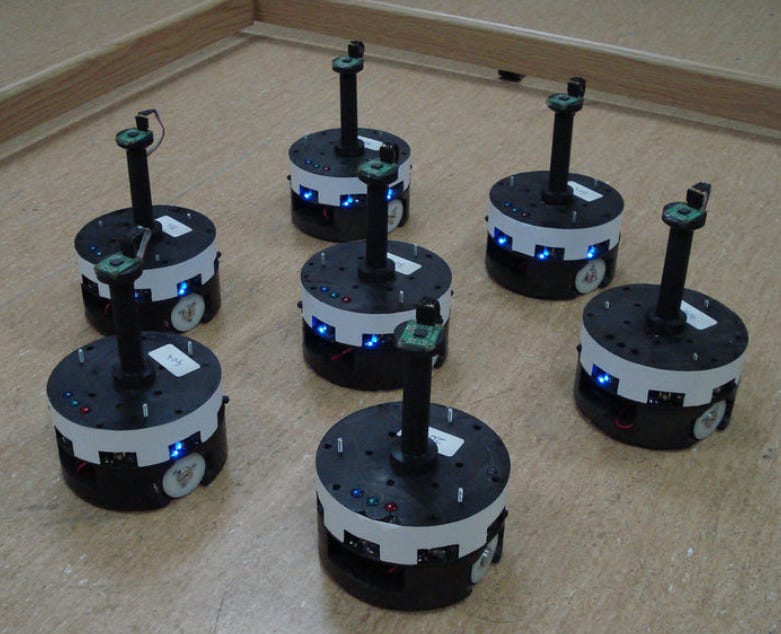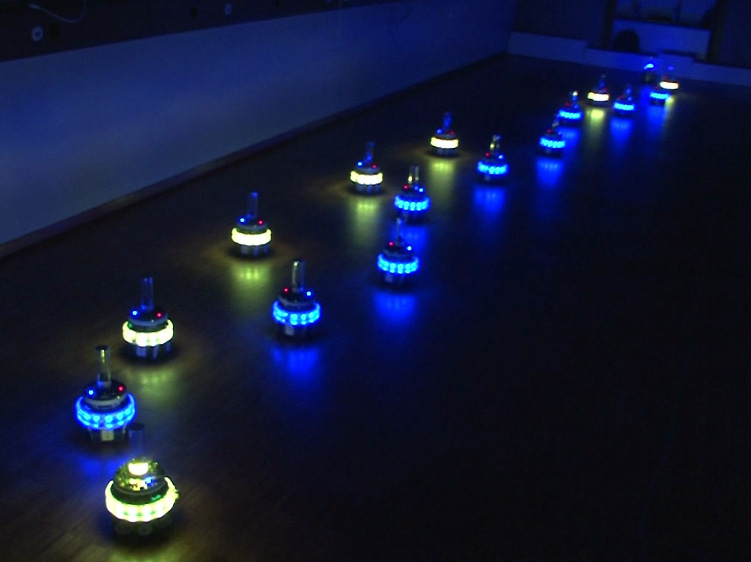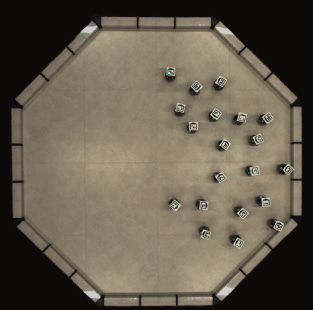Concept to Reality: Intrepid AI’s Pioneering Role in Swarm Robotics

When it comes to tech and certain applications, the word Swarm comes up in the news more and more often. For some people, the word swarm will recall honeybees as a first thought. For some others, it will recall drones and modern warfare. For a limited number of people though, working on this field in academia, research, and development, the word swarm will recall all of the above.
Swarm robotics, an academic field emerging over the past three decades, is defined as the study of how large numbers of relatively simple agents, interacting locally with each other and the environment, can exhibit desired collective behaviors. This definition, outlined in seminal articles such as those referenced [1, 2], has been fundamental in shaping the field’s trajectory.
In this definition, we have defined a certain set of dogmas regarding this approach:
Thou shall not use central computers!
Thou shall not use global interactions or communication!
All thou shall use is onboard devices and local sensing and communication.
The main reason for these dogmas is the inspiration from the field coming from biological systems.
Consider the examples below:
Here, we see natural insects solving something that for them are real problems: building a bridge to cross a chasm, selecting the shortest path, and selecting the best location to build the next colony. They do this without a GPS, without coordinating in advance with everyone, and they do not have a leader (insect queens are not involved in any of the above examples).
Guinness world record drone show Christmas 2023
Thou shall not use central computers!
All thou shall use is onboard devices,
local sensing and communication.
These are the dogmas of swarm robotics.
Not everyone respect the game.
However, a number of sectors can find those dogmas pretty useful. Those sectors include the defense industry, where infrastructures may not be reliable because under adversarial control, and where the environmental conditions could be too dynamic and unpredictable, in a way to defeat any prior planning and coordination. However, fully autonomous swarms may not comply with current regulation, dictating users need to be in the loop when it comes to making the final decisions in those applications.
Other applications where the swarm robotics dogmas are compatible, may include those in underwater or extraterrestrial environments, where localization and other human-made infrastructures are tricky to deploy. In short, you want to deploy a swarm wherever you do not want to send humans, or wherever humans have not been yet, still you want them to be somehow connected and include a human operator in the loop.
Work published in the swarm robotics field is relatively immature from a technological readiness level perspective. The vast majority on the research focuses on the development of the so called collective behaviors, that from an applied point of view represents modes of operations of a robotic swarm.
Examples of collective behaviors are: collective motion [3,4] (to navigate in the environment to scan it or sweeping it), shape formation [7] (to statically monitor the environment), collective decision making [5] (to decide, in general, who in the swarm will do what), aggregation [6] (to navigate collectively to a specific location where there is a point of interest).
To date, these collective behaviors and building blocks have been validated in laboratory conditions, but hardly make it outside in real applications. Besides different conditions, increasing the technology readiness also means finding ways to combine different collective behaviors in a way to comply with the concept of operation linked to the specific applications. A very limited amount of work has addressed this concern.
Intrepid AI as a platform is naturally supporting swarm capabilities development and can dramatically increase the maturity of swarm robotics research. As per the creed of Intrepid AI, Design – Simulate – Deploy, this can happen across the three different phases of the pipeline, and can further be powered by Intrepid AI being an all in one platform rather than a set of fragmented tools (Read our other post on the Current State of Robot Development and Intrepid AI)
Design. Low code and visual development can tremendously speed up swarm robotics capability development and especially their integration. Collective behaviors can easily be ported to Intrepid AI via the SDK, or developed from scratch using visual programming in the editor. Additionally, the visual and low code programming will allow those building blocks to be connected with each other, enabling multi-modal swarm behaviors for real world applications. The major paradigms of swarm robotics design will be supported [1], together with novel paradigms that are subject of research by the team of Intrepid AI and its network of collaborations, including AI-augmented design
Simulate. The Intrepid AI simulator has an upper edge compared to its competitors when it comes to swarm robotics capabilities validation: it achieves a superior compromise between efficiency, realism, and scalability in terms of number of simulated robots. Current tests have shown to run swarms of up to hundreds of drones, with full dynamics physics simulated, at a speed that is around 20 times faster than real time on the latest consumer GPUs. With additional software optimization and thanks to the partnership with the NVIDIA Inception Program, Intrepid AI will have access to premium grade GPUs and break the barrier of thousands of drones at 100x faster than real time. In addition, the Intrepid AI simulator will allow to generate rich environments either by hand or using AI-augmented tools. This will provide a very rich test ground to validate swarm capabilities in conditions that are very close to the real world environment, including the physics that will be boosted with AI-powered simulations. Those two features together will allow swarm capabilities to be integrated with each other and to be tested and validated in environments that are close to those of the final deployment.
Deploy. The team at Intrepid AI has started their roadmap with swarm robotics in the heart. A number of swarm robotics platforms, including aerial, are currently being validated using Intrepid AI. At the same time, their physics is being accurately modeled in the Intrepid simulator, and scenarios with robot swarms are being implemented. As relatively simple in terms of hardware and capabilities, robotic swarms represent the perfect candidate as first fully fledged use case for Intrepid AI.
Such a use case will fully validate the Intrepid paradigm Design – Simulate – Deploy in a very short time, before introducing more capable hardware and additional robotic domains (manipulations, ground vehicles, satellites, marine, underwater vehicles, etc.) Finally, Intrepid AI runtime operates with exceptional efficiency, running directly on bare hardware without any container-based, virtualization technology or other abstractions. A strong reason for limited-hardware-swarm robots to use Intrepid AI as the preferred development platform.
Intrepid AI as a platform is naturally supporting swarm capabilities development and can dramatically increase the maturity of swarm robotics research.
As we delve deeper into the fascinating world of swarm robotics, the journey becomes more intriguing with each step. If you’re as captivated by the possibilities as we are, there’s no better time to stay connected. Intrepid AI serves as a beacon for those exploring the frontiers of collective behaviors and robotic swarms.
Join our community to stay abreast of the latest developments, insights, and breakthroughs in swarm robotics. Whether you’re an enthusiast, a researcher, or a developer, there’s a place for you in our vibrant ecosystem.
Together, let’s push the boundaries of what’s possible with swarm robotics and pave the way for a future where collective intelligence knows no bounds.
References
[1] Brambilla, Manuele, Eliseo Ferrante, Mauro Birattari, and Marco Dorigo. “Swarm robotics: a review from the swarm engineering perspective.” Swarm Intelligence 7 (2013): 1-41.
[2] Şahin, Erol. “Swarm robotics: From sources of inspiration to domains of application.” In International workshop on swarm robotics, pp. 10-20. Berlin, Heidelberg: Springer Berlin Heidelberg, 2004
[3] Turgut, Ali E., Hande Çelikkanat, Fatih Gökçe, and Erol Şahin. “Self-organized flocking in mobile robot swarms.” Swarm Intelligence 2 (2008): 97-120.
[4] Ferrante, Eliseo, Ali Emre Turgut, Cristián Huepe, Alessandro Stranieri, Carlo Pinciroli, and Marco Dorigo. “Self-organized flocking with a mobile robot swarm: a novel motion control method.” Adaptive Behavior 20, no. 6 (2012): 460-477
[5] Valentini, Gabriele, Eliseo Ferrante, and Marco Dorigo. “The best-of-n problem in robot swarms: Formalization, state of the art, and novel perspectives.” Frontiers in Robotics and AI 4 (2017): 9.
[6] Soysal, Onur, Erkin Bahçeci, and Erol Şahin. “Aggregation in swarm robotic systems: Evolution and probabilistic control.” Turkish Journal of Electrical Engineering and Computer Sciences 15, no. 2 (2007): 199-225. [11:42 AM]
[7] Nouyan, Shervin, and Marco Dorigo. “Chain based path formation in swarms of robots.” In Ant Colony Optimization and Swarm Intelligence: 5th International Workshop, ANTS 2006, Brussels, Belgium, September 4-7, 2006. Proceedings 5, pp. 120-131. Springer Berlin Heidelberg, 2006.





